Perceived Organizational Support as a Predictor of Proactive Behaviour
VerifiedAdded on 2019/12/03
|12
|3785
|159
Essay
AI Summary
The provided content consists of various articles, books, and online resources related to organizational development, management, and psychology. The sources explore topics such as organization development, leadership styles, organizational citizenship behavior, job satisfaction, and employee performance. The materials also touch on the importance of positive reinforcement, feedback-seeking behavior, and mediating processes in organizations.
Contribute Materials
Your contribution can guide someone’s learning journey. Share your
documents today.
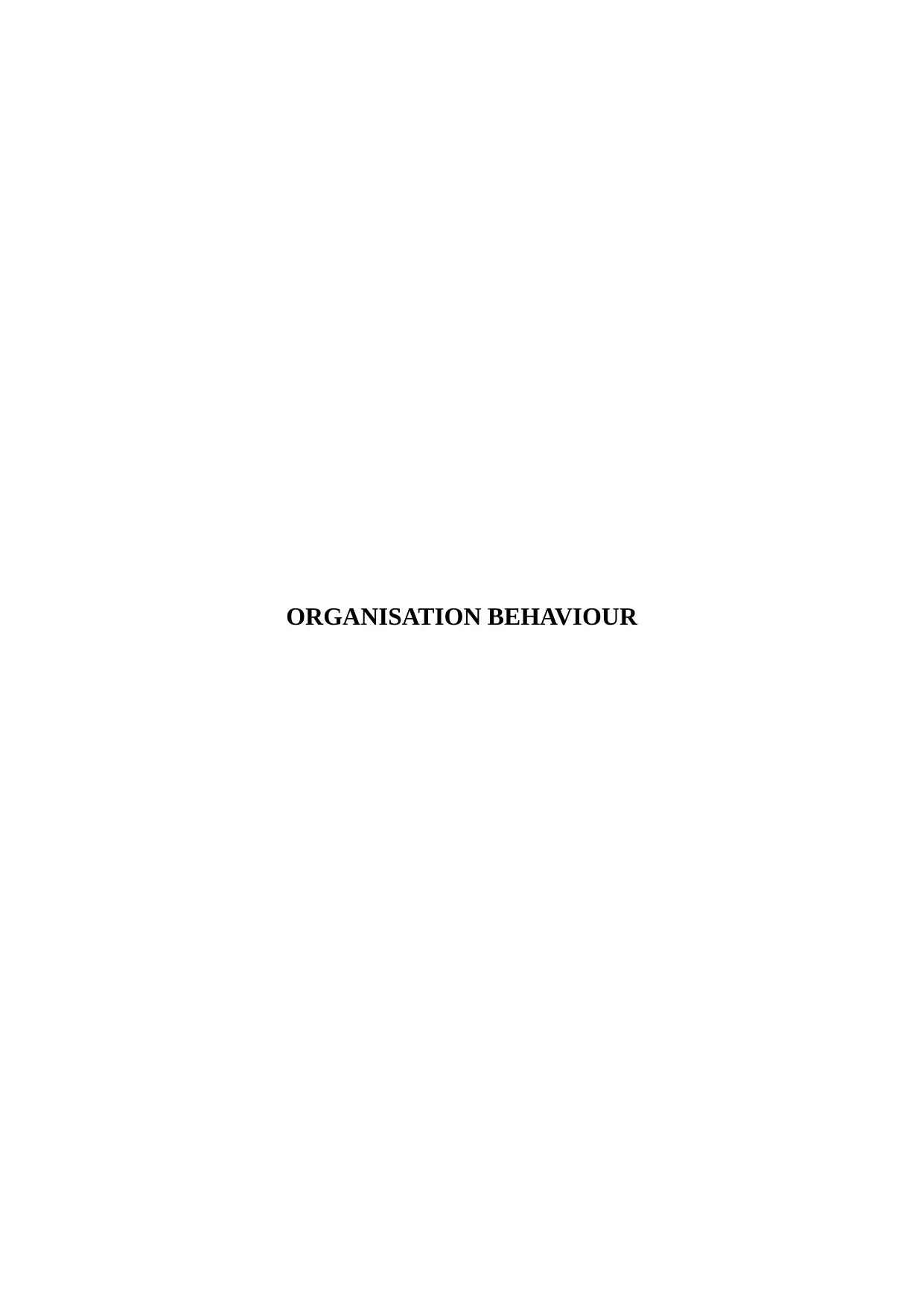
ORGANISATION BEHAVIOUR
Secure Best Marks with AI Grader
Need help grading? Try our AI Grader for instant feedback on your assignments.
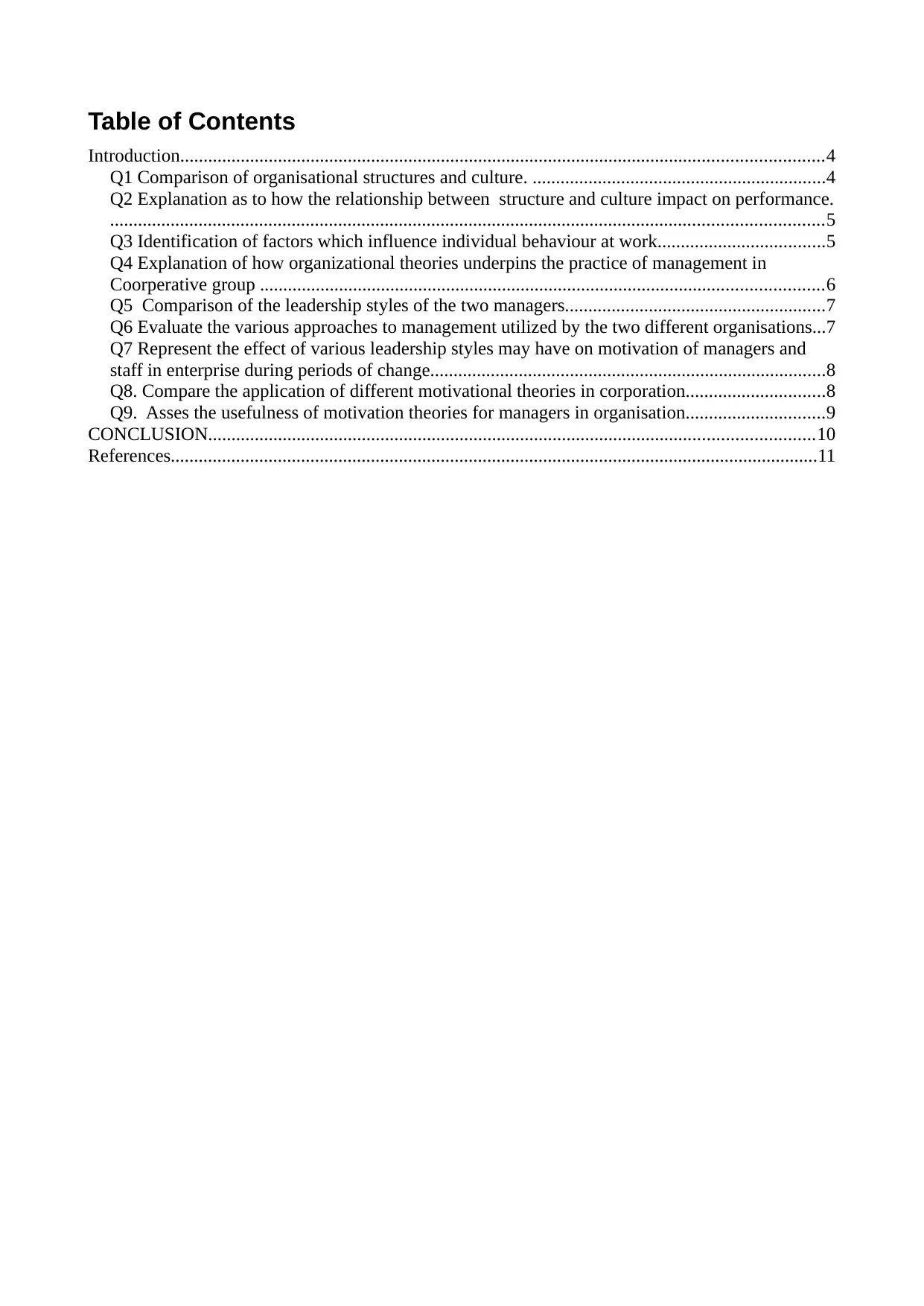
Table of Contents
Introduction..........................................................................................................................................4
Q1 Comparison of organisational structures and culture. ...............................................................4
Q2 Explanation as to how the relationship between structure and culture impact on performance.
.........................................................................................................................................................5
Q3 Identification of factors which influence individual behaviour at work....................................5
Q4 Explanation of how organizational theories underpins the practice of management in
Coorperative group .........................................................................................................................6
Q5 Comparison of the leadership styles of the two managers........................................................7
Q6 Evaluate the various approaches to management utilized by the two different organisations...7
Q7 Represent the effect of various leadership styles may have on motivation of managers and
staff in enterprise during periods of change.....................................................................................8
Q8. Compare the application of different motivational theories in corporation..............................8
Q9. Asses the usefulness of motivation theories for managers in organisation..............................9
CONCLUSION..................................................................................................................................10
References...........................................................................................................................................11
Introduction..........................................................................................................................................4
Q1 Comparison of organisational structures and culture. ...............................................................4
Q2 Explanation as to how the relationship between structure and culture impact on performance.
.........................................................................................................................................................5
Q3 Identification of factors which influence individual behaviour at work....................................5
Q4 Explanation of how organizational theories underpins the practice of management in
Coorperative group .........................................................................................................................6
Q5 Comparison of the leadership styles of the two managers........................................................7
Q6 Evaluate the various approaches to management utilized by the two different organisations...7
Q7 Represent the effect of various leadership styles may have on motivation of managers and
staff in enterprise during periods of change.....................................................................................8
Q8. Compare the application of different motivational theories in corporation..............................8
Q9. Asses the usefulness of motivation theories for managers in organisation..............................9
CONCLUSION..................................................................................................................................10
References...........................................................................................................................................11
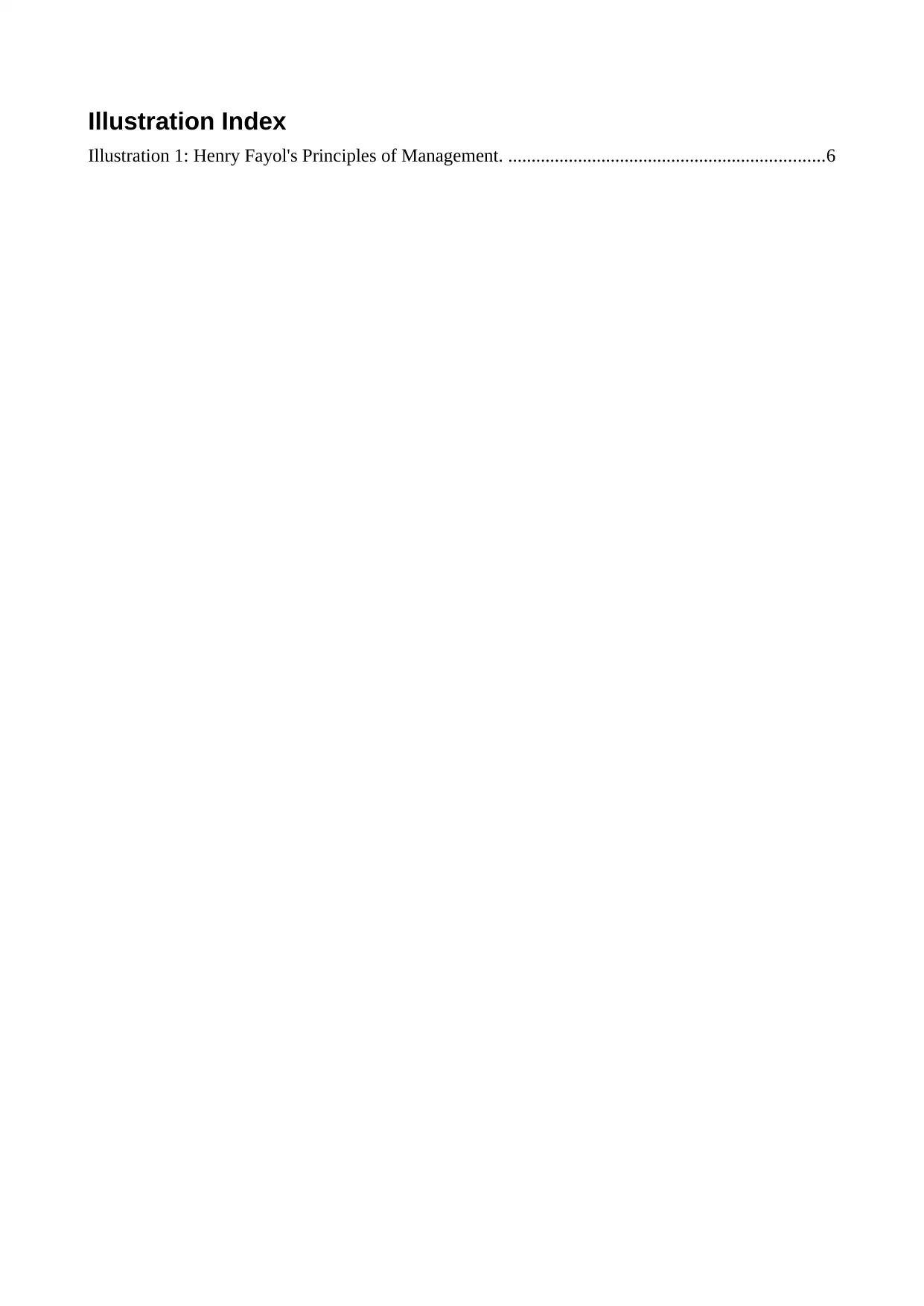
Illustration Index
Illustration 1: Henry Fayol's Principles of Management. ....................................................................6
Illustration 1: Henry Fayol's Principles of Management. ....................................................................6
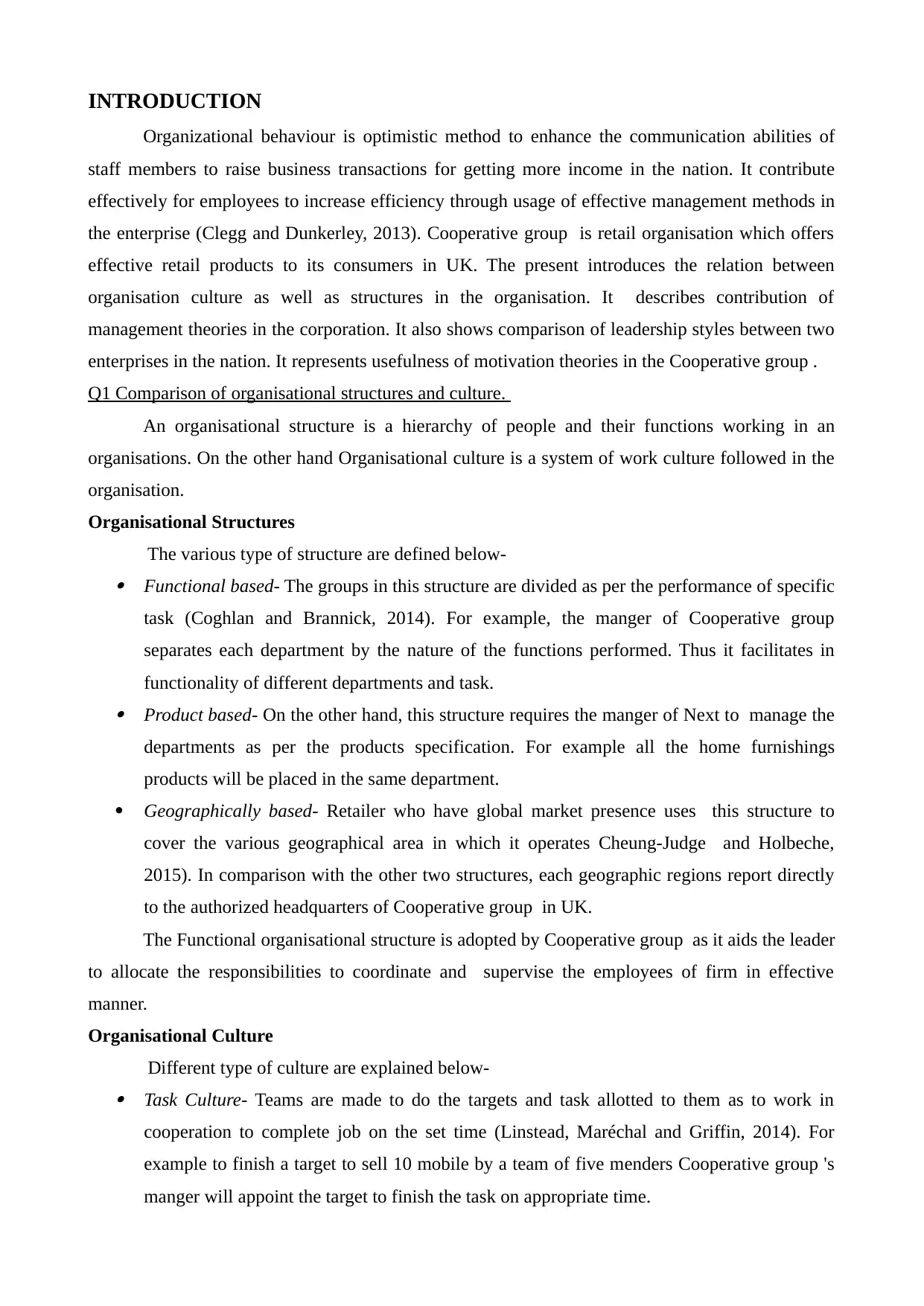
INTRODUCTION
Organizational behaviour is optimistic method to enhance the communication abilities of
staff members to raise business transactions for getting more income in the nation. It contribute
effectively for employees to increase efficiency through usage of effective management methods in
the enterprise (Clegg and Dunkerley, 2013). Cooperative group is retail organisation which offers
effective retail products to its consumers in UK. The present introduces the relation between
organisation culture as well as structures in the organisation. It describes contribution of
management theories in the corporation. It also shows comparison of leadership styles between two
enterprises in the nation. It represents usefulness of motivation theories in the Cooperative group .
Q1 Comparison of organisational structures and culture.
An organisational structure is a hierarchy of people and their functions working in an
organisations. On the other hand Organisational culture is a system of work culture followed in the
organisation.
Organisational Structures
The various type of structure are defined below- Functional based- The groups in this structure are divided as per the performance of specific
task (Coghlan and Brannick, 2014). For example, the manger of Cooperative group
separates each department by the nature of the functions performed. Thus it facilitates in
functionality of different departments and task. Product based- On the other hand, this structure requires the manger of Next to manage the
departments as per the products specification. For example all the home furnishings
products will be placed in the same department.
Geographically based- Retailer who have global market presence uses this structure to
cover the various geographical area in which it operates Cheung-Judge and Holbeche,
2015). In comparison with the other two structures, each geographic regions report directly
to the authorized headquarters of Cooperative group in UK.
The Functional organisational structure is adopted by Cooperative group as it aids the leader
to allocate the responsibilities to coordinate and supervise the employees of firm in effective
manner.
Organisational Culture
Different type of culture are explained below- Task Culture- Teams are made to do the targets and task allotted to them as to work in
cooperation to complete job on the set time (Linstead, Maréchal and Griffin, 2014). For
example to finish a target to sell 10 mobile by a team of five menders Cooperative group 's
manger will appoint the target to finish the task on appropriate time.
Organizational behaviour is optimistic method to enhance the communication abilities of
staff members to raise business transactions for getting more income in the nation. It contribute
effectively for employees to increase efficiency through usage of effective management methods in
the enterprise (Clegg and Dunkerley, 2013). Cooperative group is retail organisation which offers
effective retail products to its consumers in UK. The present introduces the relation between
organisation culture as well as structures in the organisation. It describes contribution of
management theories in the corporation. It also shows comparison of leadership styles between two
enterprises in the nation. It represents usefulness of motivation theories in the Cooperative group .
Q1 Comparison of organisational structures and culture.
An organisational structure is a hierarchy of people and their functions working in an
organisations. On the other hand Organisational culture is a system of work culture followed in the
organisation.
Organisational Structures
The various type of structure are defined below- Functional based- The groups in this structure are divided as per the performance of specific
task (Coghlan and Brannick, 2014). For example, the manger of Cooperative group
separates each department by the nature of the functions performed. Thus it facilitates in
functionality of different departments and task. Product based- On the other hand, this structure requires the manger of Next to manage the
departments as per the products specification. For example all the home furnishings
products will be placed in the same department.
Geographically based- Retailer who have global market presence uses this structure to
cover the various geographical area in which it operates Cheung-Judge and Holbeche,
2015). In comparison with the other two structures, each geographic regions report directly
to the authorized headquarters of Cooperative group in UK.
The Functional organisational structure is adopted by Cooperative group as it aids the leader
to allocate the responsibilities to coordinate and supervise the employees of firm in effective
manner.
Organisational Culture
Different type of culture are explained below- Task Culture- Teams are made to do the targets and task allotted to them as to work in
cooperation to complete job on the set time (Linstead, Maréchal and Griffin, 2014). For
example to finish a target to sell 10 mobile by a team of five menders Cooperative group 's
manger will appoint the target to finish the task on appropriate time.
Secure Best Marks with AI Grader
Need help grading? Try our AI Grader for instant feedback on your assignments.
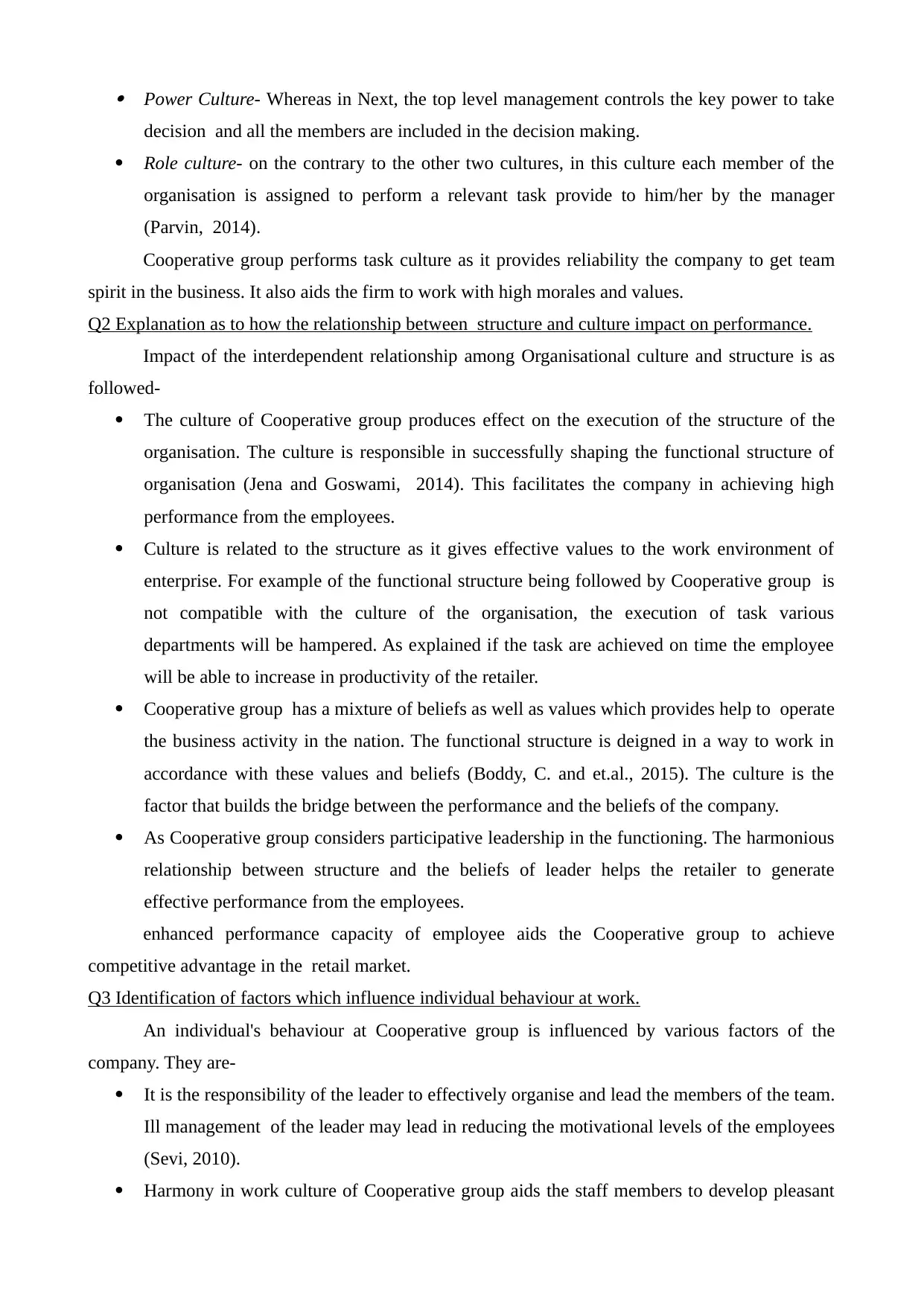
Power Culture- Whereas in Next, the top level management controls the key power to take
decision and all the members are included in the decision making.
Role culture- on the contrary to the other two cultures, in this culture each member of the
organisation is assigned to perform a relevant task provide to him/her by the manager
(Parvin, 2014).
Cooperative group performs task culture as it provides reliability the company to get team
spirit in the business. It also aids the firm to work with high morales and values.
Q2 Explanation as to how the relationship between structure and culture impact on performance.
Impact of the interdependent relationship among Organisational culture and structure is as
followed-
The culture of Cooperative group produces effect on the execution of the structure of the
organisation. The culture is responsible in successfully shaping the functional structure of
organisation (Jena and Goswami, 2014). This facilitates the company in achieving high
performance from the employees.
Culture is related to the structure as it gives effective values to the work environment of
enterprise. For example of the functional structure being followed by Cooperative group is
not compatible with the culture of the organisation, the execution of task various
departments will be hampered. As explained if the task are achieved on time the employee
will be able to increase in productivity of the retailer.
Cooperative group has a mixture of beliefs as well as values which provides help to operate
the business activity in the nation. The functional structure is deigned in a way to work in
accordance with these values and beliefs (Boddy, C. and et.al., 2015). The culture is the
factor that builds the bridge between the performance and the beliefs of the company.
As Cooperative group considers participative leadership in the functioning. The harmonious
relationship between structure and the beliefs of leader helps the retailer to generate
effective performance from the employees.
enhanced performance capacity of employee aids the Cooperative group to achieve
competitive advantage in the retail market.
Q3 Identification of factors which influence individual behaviour at work.
An individual's behaviour at Cooperative group is influenced by various factors of the
company. They are-
It is the responsibility of the leader to effectively organise and lead the members of the team.
Ill management of the leader may lead in reducing the motivational levels of the employees
(Sevi, 2010).
Harmony in work culture of Cooperative group aids the staff members to develop pleasant
decision and all the members are included in the decision making.
Role culture- on the contrary to the other two cultures, in this culture each member of the
organisation is assigned to perform a relevant task provide to him/her by the manager
(Parvin, 2014).
Cooperative group performs task culture as it provides reliability the company to get team
spirit in the business. It also aids the firm to work with high morales and values.
Q2 Explanation as to how the relationship between structure and culture impact on performance.
Impact of the interdependent relationship among Organisational culture and structure is as
followed-
The culture of Cooperative group produces effect on the execution of the structure of the
organisation. The culture is responsible in successfully shaping the functional structure of
organisation (Jena and Goswami, 2014). This facilitates the company in achieving high
performance from the employees.
Culture is related to the structure as it gives effective values to the work environment of
enterprise. For example of the functional structure being followed by Cooperative group is
not compatible with the culture of the organisation, the execution of task various
departments will be hampered. As explained if the task are achieved on time the employee
will be able to increase in productivity of the retailer.
Cooperative group has a mixture of beliefs as well as values which provides help to operate
the business activity in the nation. The functional structure is deigned in a way to work in
accordance with these values and beliefs (Boddy, C. and et.al., 2015). The culture is the
factor that builds the bridge between the performance and the beliefs of the company.
As Cooperative group considers participative leadership in the functioning. The harmonious
relationship between structure and the beliefs of leader helps the retailer to generate
effective performance from the employees.
enhanced performance capacity of employee aids the Cooperative group to achieve
competitive advantage in the retail market.
Q3 Identification of factors which influence individual behaviour at work.
An individual's behaviour at Cooperative group is influenced by various factors of the
company. They are-
It is the responsibility of the leader to effectively organise and lead the members of the team.
Ill management of the leader may lead in reducing the motivational levels of the employees
(Sevi, 2010).
Harmony in work culture of Cooperative group aids the staff members to develop pleasant
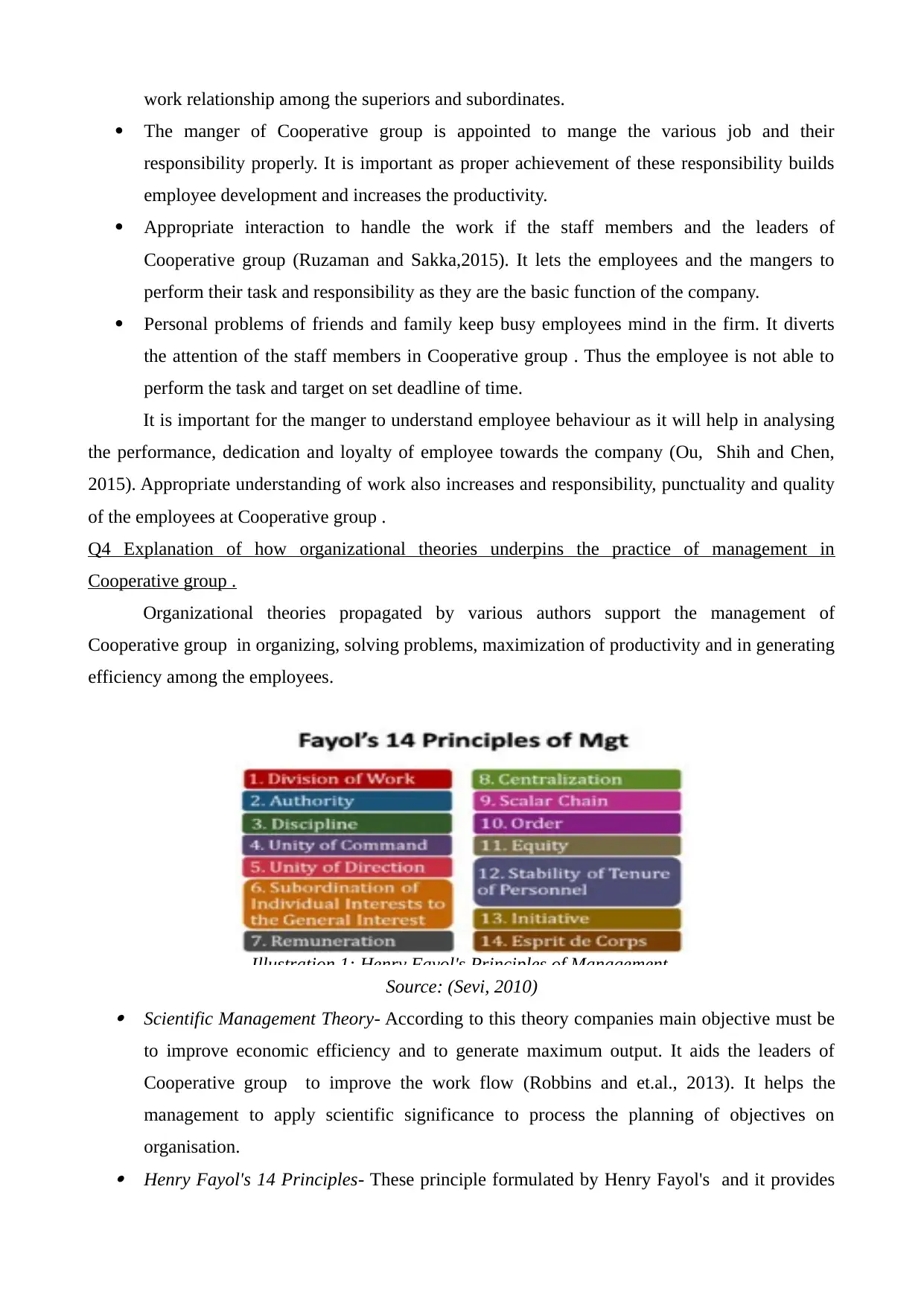
work relationship among the superiors and subordinates.
The manger of Cooperative group is appointed to mange the various job and their
responsibility properly. It is important as proper achievement of these responsibility builds
employee development and increases the productivity.
Appropriate interaction to handle the work if the staff members and the leaders of
Cooperative group (Ruzaman and Sakka,2015). It lets the employees and the mangers to
perform their task and responsibility as they are the basic function of the company.
Personal problems of friends and family keep busy employees mind in the firm. It diverts
the attention of the staff members in Cooperative group . Thus the employee is not able to
perform the task and target on set deadline of time.
It is important for the manger to understand employee behaviour as it will help in analysing
the performance, dedication and loyalty of employee towards the company (Ou, Shih and Chen,
2015). Appropriate understanding of work also increases and responsibility, punctuality and quality
of the employees at Cooperative group .
Q4 Explanation of how organizational theories underpins the practice of management in
Cooperative group .
Organizational theories propagated by various authors support the management of
Cooperative group in organizing, solving problems, maximization of productivity and in generating
efficiency among the employees.
Source: (Sevi, 2010) Scientific Management Theory- According to this theory companies main objective must be
to improve economic efficiency and to generate maximum output. It aids the leaders of
Cooperative group to improve the work flow (Robbins and et.al., 2013). It helps the
management to apply scientific significance to process the planning of objectives on
organisation. Henry Fayol's 14 Principles- These principle formulated by Henry Fayol's and it provides
Illustration 1: Henry Fayol's Principles of Management.
The manger of Cooperative group is appointed to mange the various job and their
responsibility properly. It is important as proper achievement of these responsibility builds
employee development and increases the productivity.
Appropriate interaction to handle the work if the staff members and the leaders of
Cooperative group (Ruzaman and Sakka,2015). It lets the employees and the mangers to
perform their task and responsibility as they are the basic function of the company.
Personal problems of friends and family keep busy employees mind in the firm. It diverts
the attention of the staff members in Cooperative group . Thus the employee is not able to
perform the task and target on set deadline of time.
It is important for the manger to understand employee behaviour as it will help in analysing
the performance, dedication and loyalty of employee towards the company (Ou, Shih and Chen,
2015). Appropriate understanding of work also increases and responsibility, punctuality and quality
of the employees at Cooperative group .
Q4 Explanation of how organizational theories underpins the practice of management in
Cooperative group .
Organizational theories propagated by various authors support the management of
Cooperative group in organizing, solving problems, maximization of productivity and in generating
efficiency among the employees.
Source: (Sevi, 2010) Scientific Management Theory- According to this theory companies main objective must be
to improve economic efficiency and to generate maximum output. It aids the leaders of
Cooperative group to improve the work flow (Robbins and et.al., 2013). It helps the
management to apply scientific significance to process the planning of objectives on
organisation. Henry Fayol's 14 Principles- These principle formulated by Henry Fayol's and it provides
Illustration 1: Henry Fayol's Principles of Management.
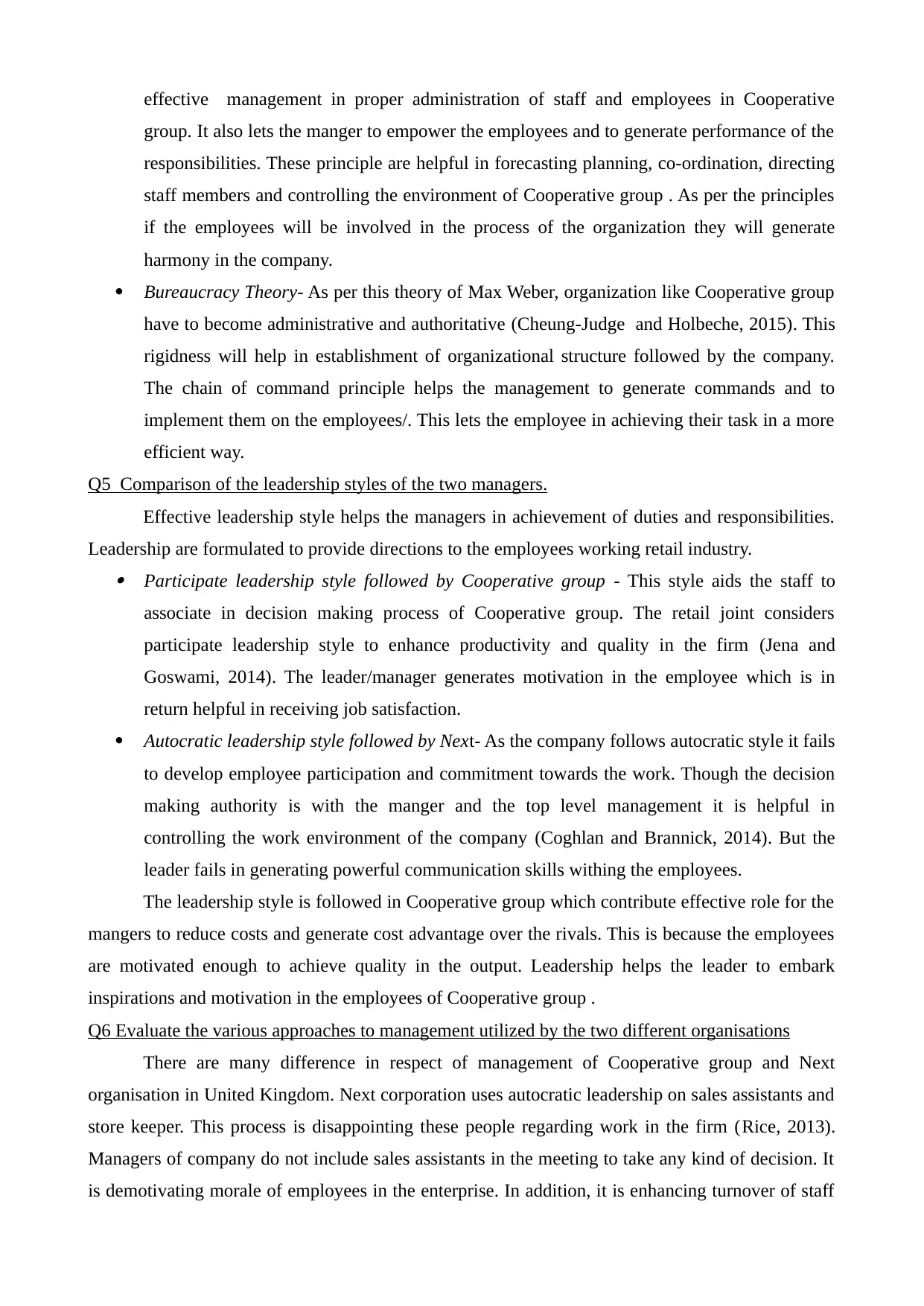
effective management in proper administration of staff and employees in Cooperative
group. It also lets the manger to empower the employees and to generate performance of the
responsibilities. These principle are helpful in forecasting planning, co-ordination, directing
staff members and controlling the environment of Cooperative group . As per the principles
if the employees will be involved in the process of the organization they will generate
harmony in the company.
Bureaucracy Theory- As per this theory of Max Weber, organization like Cooperative group
have to become administrative and authoritative (Cheung-Judge and Holbeche, 2015). This
rigidness will help in establishment of organizational structure followed by the company.
The chain of command principle helps the management to generate commands and to
implement them on the employees/. This lets the employee in achieving their task in a more
efficient way.
Q5 Comparison of the leadership styles of the two managers.
Effective leadership style helps the managers in achievement of duties and responsibilities.
Leadership are formulated to provide directions to the employees working retail industry. Participate leadership style followed by Cooperative group - This style aids the staff to
associate in decision making process of Cooperative group. The retail joint considers
participate leadership style to enhance productivity and quality in the firm (Jena and
Goswami, 2014). The leader/manager generates motivation in the employee which is in
return helpful in receiving job satisfaction.
Autocratic leadership style followed by Next- As the company follows autocratic style it fails
to develop employee participation and commitment towards the work. Though the decision
making authority is with the manger and the top level management it is helpful in
controlling the work environment of the company (Coghlan and Brannick, 2014). But the
leader fails in generating powerful communication skills withing the employees.
The leadership style is followed in Cooperative group which contribute effective role for the
mangers to reduce costs and generate cost advantage over the rivals. This is because the employees
are motivated enough to achieve quality in the output. Leadership helps the leader to embark
inspirations and motivation in the employees of Cooperative group .
Q6 Evaluate the various approaches to management utilized by the two different organisations
There are many difference in respect of management of Cooperative group and Next
organisation in United Kingdom. Next corporation uses autocratic leadership on sales assistants and
store keeper. This process is disappointing these people regarding work in the firm (Rice, 2013).
Managers of company do not include sales assistants in the meeting to take any kind of decision. It
is demotivating morale of employees in the enterprise. In addition, it is enhancing turnover of staff
group. It also lets the manger to empower the employees and to generate performance of the
responsibilities. These principle are helpful in forecasting planning, co-ordination, directing
staff members and controlling the environment of Cooperative group . As per the principles
if the employees will be involved in the process of the organization they will generate
harmony in the company.
Bureaucracy Theory- As per this theory of Max Weber, organization like Cooperative group
have to become administrative and authoritative (Cheung-Judge and Holbeche, 2015). This
rigidness will help in establishment of organizational structure followed by the company.
The chain of command principle helps the management to generate commands and to
implement them on the employees/. This lets the employee in achieving their task in a more
efficient way.
Q5 Comparison of the leadership styles of the two managers.
Effective leadership style helps the managers in achievement of duties and responsibilities.
Leadership are formulated to provide directions to the employees working retail industry. Participate leadership style followed by Cooperative group - This style aids the staff to
associate in decision making process of Cooperative group. The retail joint considers
participate leadership style to enhance productivity and quality in the firm (Jena and
Goswami, 2014). The leader/manager generates motivation in the employee which is in
return helpful in receiving job satisfaction.
Autocratic leadership style followed by Next- As the company follows autocratic style it fails
to develop employee participation and commitment towards the work. Though the decision
making authority is with the manger and the top level management it is helpful in
controlling the work environment of the company (Coghlan and Brannick, 2014). But the
leader fails in generating powerful communication skills withing the employees.
The leadership style is followed in Cooperative group which contribute effective role for the
mangers to reduce costs and generate cost advantage over the rivals. This is because the employees
are motivated enough to achieve quality in the output. Leadership helps the leader to embark
inspirations and motivation in the employees of Cooperative group .
Q6 Evaluate the various approaches to management utilized by the two different organisations
There are many difference in respect of management of Cooperative group and Next
organisation in United Kingdom. Next corporation uses autocratic leadership on sales assistants and
store keeper. This process is disappointing these people regarding work in the firm (Rice, 2013).
Managers of company do not include sales assistants in the meeting to take any kind of decision. It
is demotivating morale of employees in the enterprise. In addition, it is enhancing turnover of staff
Paraphrase This Document
Need a fresh take? Get an instant paraphrase of this document with our AI Paraphraser
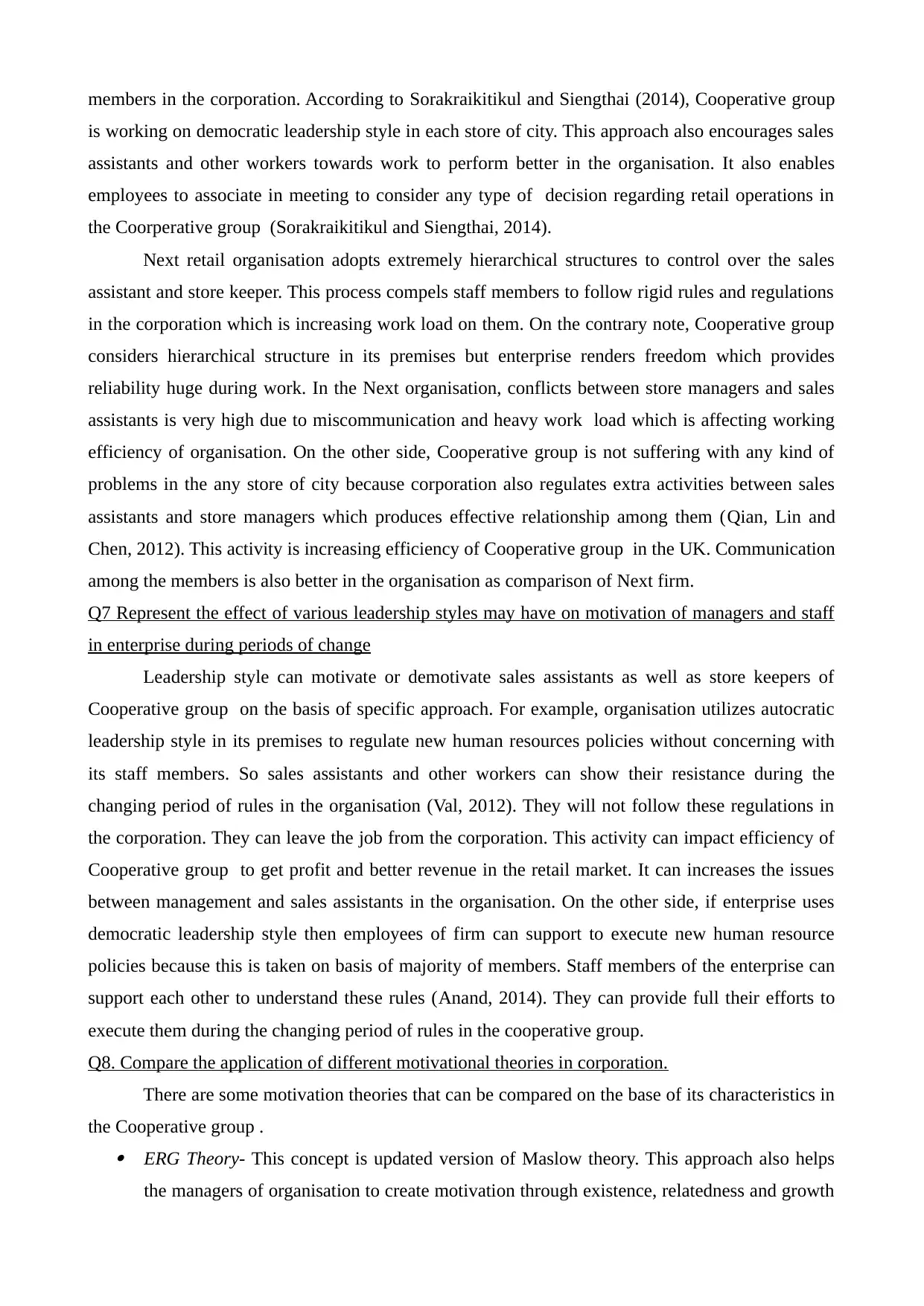
members in the corporation. According to Sorakraikitikul and Siengthai (2014), Cooperative group
is working on democratic leadership style in each store of city. This approach also encourages sales
assistants and other workers towards work to perform better in the organisation. It also enables
employees to associate in meeting to consider any type of decision regarding retail operations in
the Coorperative group (Sorakraikitikul and Siengthai, 2014).
Next retail organisation adopts extremely hierarchical structures to control over the sales
assistant and store keeper. This process compels staff members to follow rigid rules and regulations
in the corporation which is increasing work load on them. On the contrary note, Cooperative group
considers hierarchical structure in its premises but enterprise renders freedom which provides
reliability huge during work. In the Next organisation, conflicts between store managers and sales
assistants is very high due to miscommunication and heavy work load which is affecting working
efficiency of organisation. On the other side, Cooperative group is not suffering with any kind of
problems in the any store of city because corporation also regulates extra activities between sales
assistants and store managers which produces effective relationship among them (Qian, Lin and
Chen, 2012). This activity is increasing efficiency of Cooperative group in the UK. Communication
among the members is also better in the organisation as comparison of Next firm.
Q7 Represent the effect of various leadership styles may have on motivation of managers and staff
in enterprise during periods of change
Leadership style can motivate or demotivate sales assistants as well as store keepers of
Cooperative group on the basis of specific approach. For example, organisation utilizes autocratic
leadership style in its premises to regulate new human resources policies without concerning with
its staff members. So sales assistants and other workers can show their resistance during the
changing period of rules in the organisation (Val, 2012). They will not follow these regulations in
the corporation. They can leave the job from the corporation. This activity can impact efficiency of
Cooperative group to get profit and better revenue in the retail market. It can increases the issues
between management and sales assistants in the organisation. On the other side, if enterprise uses
democratic leadership style then employees of firm can support to execute new human resource
policies because this is taken on basis of majority of members. Staff members of the enterprise can
support each other to understand these rules (Anand, 2014). They can provide full their efforts to
execute them during the changing period of rules in the cooperative group.
Q8. Compare the application of different motivational theories in corporation.
There are some motivation theories that can be compared on the base of its characteristics in
the Cooperative group . ERG Theory- This concept is updated version of Maslow theory. This approach also helps
the managers of organisation to create motivation through existence, relatedness and growth
is working on democratic leadership style in each store of city. This approach also encourages sales
assistants and other workers towards work to perform better in the organisation. It also enables
employees to associate in meeting to consider any type of decision regarding retail operations in
the Coorperative group (Sorakraikitikul and Siengthai, 2014).
Next retail organisation adopts extremely hierarchical structures to control over the sales
assistant and store keeper. This process compels staff members to follow rigid rules and regulations
in the corporation which is increasing work load on them. On the contrary note, Cooperative group
considers hierarchical structure in its premises but enterprise renders freedom which provides
reliability huge during work. In the Next organisation, conflicts between store managers and sales
assistants is very high due to miscommunication and heavy work load which is affecting working
efficiency of organisation. On the other side, Cooperative group is not suffering with any kind of
problems in the any store of city because corporation also regulates extra activities between sales
assistants and store managers which produces effective relationship among them (Qian, Lin and
Chen, 2012). This activity is increasing efficiency of Cooperative group in the UK. Communication
among the members is also better in the organisation as comparison of Next firm.
Q7 Represent the effect of various leadership styles may have on motivation of managers and staff
in enterprise during periods of change
Leadership style can motivate or demotivate sales assistants as well as store keepers of
Cooperative group on the basis of specific approach. For example, organisation utilizes autocratic
leadership style in its premises to regulate new human resources policies without concerning with
its staff members. So sales assistants and other workers can show their resistance during the
changing period of rules in the organisation (Val, 2012). They will not follow these regulations in
the corporation. They can leave the job from the corporation. This activity can impact efficiency of
Cooperative group to get profit and better revenue in the retail market. It can increases the issues
between management and sales assistants in the organisation. On the other side, if enterprise uses
democratic leadership style then employees of firm can support to execute new human resource
policies because this is taken on basis of majority of members. Staff members of the enterprise can
support each other to understand these rules (Anand, 2014). They can provide full their efforts to
execute them during the changing period of rules in the cooperative group.
Q8. Compare the application of different motivational theories in corporation.
There are some motivation theories that can be compared on the base of its characteristics in
the Cooperative group . ERG Theory- This concept is updated version of Maslow theory. This approach also helps
the managers of organisation to create motivation through existence, relatedness and growth
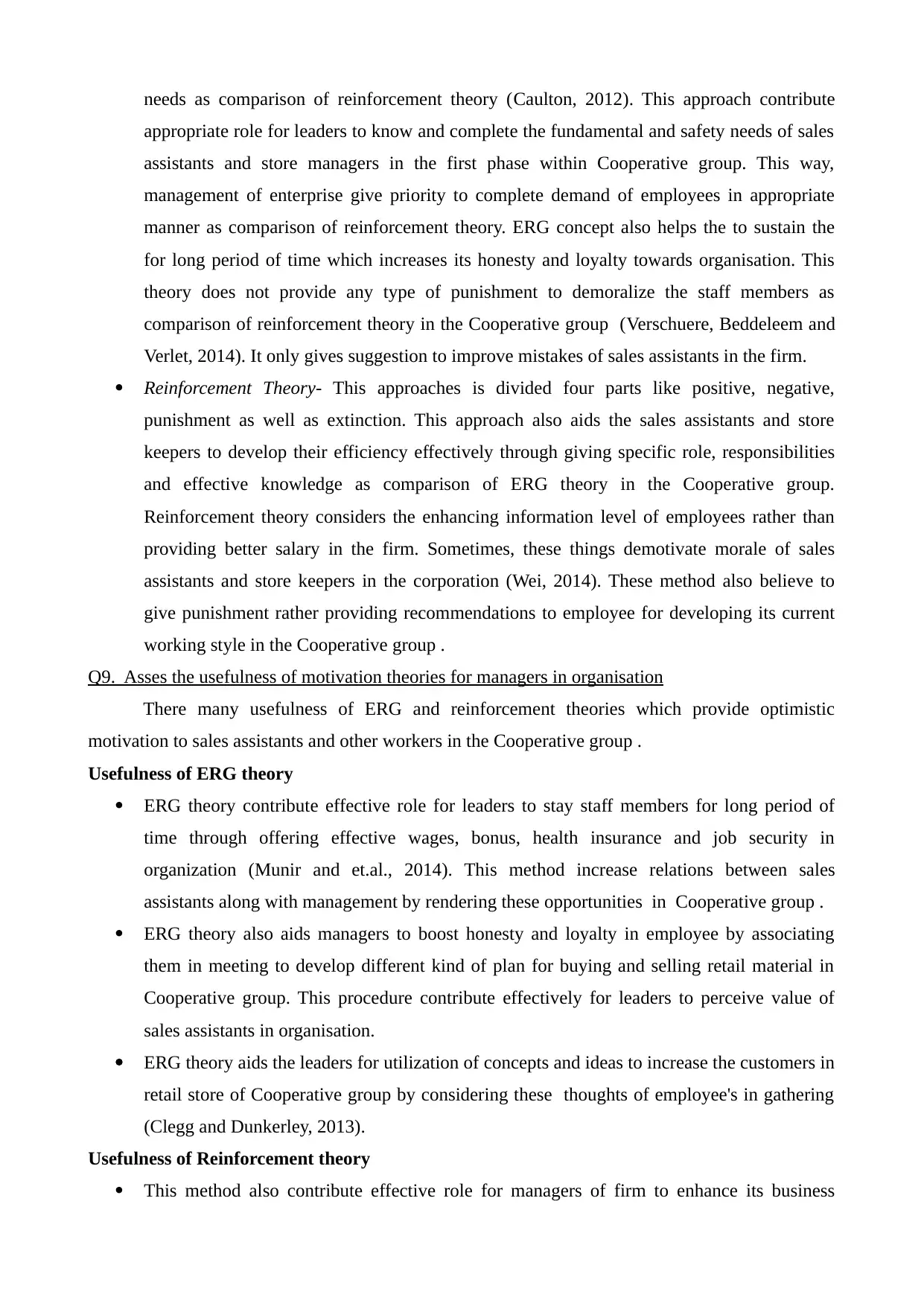
needs as comparison of reinforcement theory (Caulton, 2012). This approach contribute
appropriate role for leaders to know and complete the fundamental and safety needs of sales
assistants and store managers in the first phase within Cooperative group. This way,
management of enterprise give priority to complete demand of employees in appropriate
manner as comparison of reinforcement theory. ERG concept also helps the to sustain the
for long period of time which increases its honesty and loyalty towards organisation. This
theory does not provide any type of punishment to demoralize the staff members as
comparison of reinforcement theory in the Cooperative group (Verschuere, Beddeleem and
Verlet, 2014). It only gives suggestion to improve mistakes of sales assistants in the firm.
Reinforcement Theory- This approaches is divided four parts like positive, negative,
punishment as well as extinction. This approach also aids the sales assistants and store
keepers to develop their efficiency effectively through giving specific role, responsibilities
and effective knowledge as comparison of ERG theory in the Cooperative group.
Reinforcement theory considers the enhancing information level of employees rather than
providing better salary in the firm. Sometimes, these things demotivate morale of sales
assistants and store keepers in the corporation (Wei, 2014). These method also believe to
give punishment rather providing recommendations to employee for developing its current
working style in the Cooperative group .
Q9. Asses the usefulness of motivation theories for managers in organisation
There many usefulness of ERG and reinforcement theories which provide optimistic
motivation to sales assistants and other workers in the Cooperative group .
Usefulness of ERG theory
ERG theory contribute effective role for leaders to stay staff members for long period of
time through offering effective wages, bonus, health insurance and job security in
organization (Munir and et.al., 2014). This method increase relations between sales
assistants along with management by rendering these opportunities in Cooperative group .
ERG theory also aids managers to boost honesty and loyalty in employee by associating
them in meeting to develop different kind of plan for buying and selling retail material in
Cooperative group. This procedure contribute effectively for leaders to perceive value of
sales assistants in organisation.
ERG theory aids the leaders for utilization of concepts and ideas to increase the customers in
retail store of Cooperative group by considering these thoughts of employee's in gathering
(Clegg and Dunkerley, 2013).
Usefulness of Reinforcement theory
This method also contribute effective role for managers of firm to enhance its business
appropriate role for leaders to know and complete the fundamental and safety needs of sales
assistants and store managers in the first phase within Cooperative group. This way,
management of enterprise give priority to complete demand of employees in appropriate
manner as comparison of reinforcement theory. ERG concept also helps the to sustain the
for long period of time which increases its honesty and loyalty towards organisation. This
theory does not provide any type of punishment to demoralize the staff members as
comparison of reinforcement theory in the Cooperative group (Verschuere, Beddeleem and
Verlet, 2014). It only gives suggestion to improve mistakes of sales assistants in the firm.
Reinforcement Theory- This approaches is divided four parts like positive, negative,
punishment as well as extinction. This approach also aids the sales assistants and store
keepers to develop their efficiency effectively through giving specific role, responsibilities
and effective knowledge as comparison of ERG theory in the Cooperative group.
Reinforcement theory considers the enhancing information level of employees rather than
providing better salary in the firm. Sometimes, these things demotivate morale of sales
assistants and store keepers in the corporation (Wei, 2014). These method also believe to
give punishment rather providing recommendations to employee for developing its current
working style in the Cooperative group .
Q9. Asses the usefulness of motivation theories for managers in organisation
There many usefulness of ERG and reinforcement theories which provide optimistic
motivation to sales assistants and other workers in the Cooperative group .
Usefulness of ERG theory
ERG theory contribute effective role for leaders to stay staff members for long period of
time through offering effective wages, bonus, health insurance and job security in
organization (Munir and et.al., 2014). This method increase relations between sales
assistants along with management by rendering these opportunities in Cooperative group .
ERG theory also aids managers to boost honesty and loyalty in employee by associating
them in meeting to develop different kind of plan for buying and selling retail material in
Cooperative group. This procedure contribute effectively for leaders to perceive value of
sales assistants in organisation.
ERG theory aids the leaders for utilization of concepts and ideas to increase the customers in
retail store of Cooperative group by considering these thoughts of employee's in gathering
(Clegg and Dunkerley, 2013).
Usefulness of Reinforcement theory
This method also contribute effective role for managers of firm to enhance its business
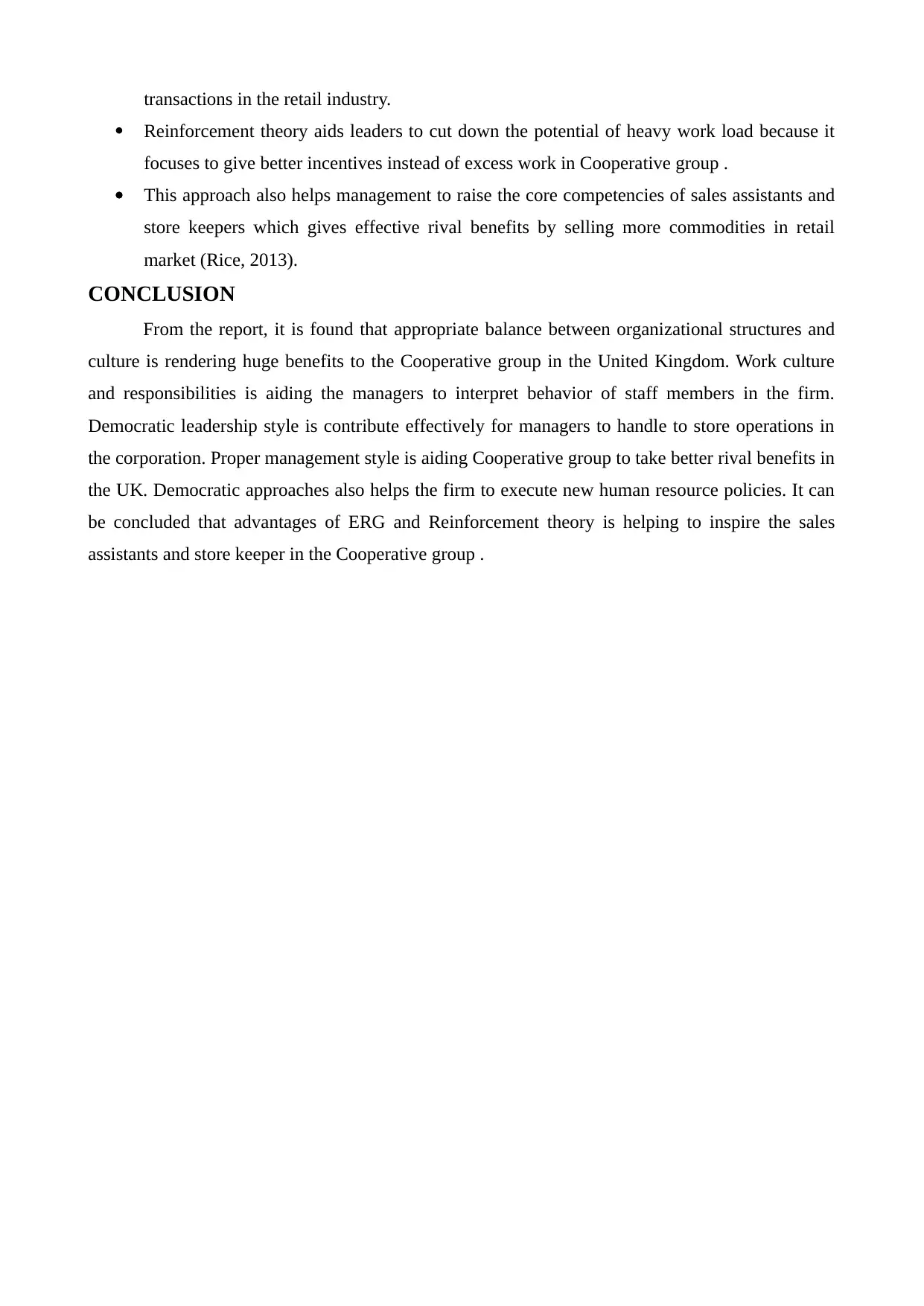
transactions in the retail industry.
Reinforcement theory aids leaders to cut down the potential of heavy work load because it
focuses to give better incentives instead of excess work in Cooperative group .
This approach also helps management to raise the core competencies of sales assistants and
store keepers which gives effective rival benefits by selling more commodities in retail
market (Rice, 2013).
CONCLUSION
From the report, it is found that appropriate balance between organizational structures and
culture is rendering huge benefits to the Cooperative group in the United Kingdom. Work culture
and responsibilities is aiding the managers to interpret behavior of staff members in the firm.
Democratic leadership style is contribute effectively for managers to handle to store operations in
the corporation. Proper management style is aiding Cooperative group to take better rival benefits in
the UK. Democratic approaches also helps the firm to execute new human resource policies. It can
be concluded that advantages of ERG and Reinforcement theory is helping to inspire the sales
assistants and store keeper in the Cooperative group .
Reinforcement theory aids leaders to cut down the potential of heavy work load because it
focuses to give better incentives instead of excess work in Cooperative group .
This approach also helps management to raise the core competencies of sales assistants and
store keepers which gives effective rival benefits by selling more commodities in retail
market (Rice, 2013).
CONCLUSION
From the report, it is found that appropriate balance between organizational structures and
culture is rendering huge benefits to the Cooperative group in the United Kingdom. Work culture
and responsibilities is aiding the managers to interpret behavior of staff members in the firm.
Democratic leadership style is contribute effectively for managers to handle to store operations in
the corporation. Proper management style is aiding Cooperative group to take better rival benefits in
the UK. Democratic approaches also helps the firm to execute new human resource policies. It can
be concluded that advantages of ERG and Reinforcement theory is helping to inspire the sales
assistants and store keeper in the Cooperative group .
Secure Best Marks with AI Grader
Need help grading? Try our AI Grader for instant feedback on your assignments.
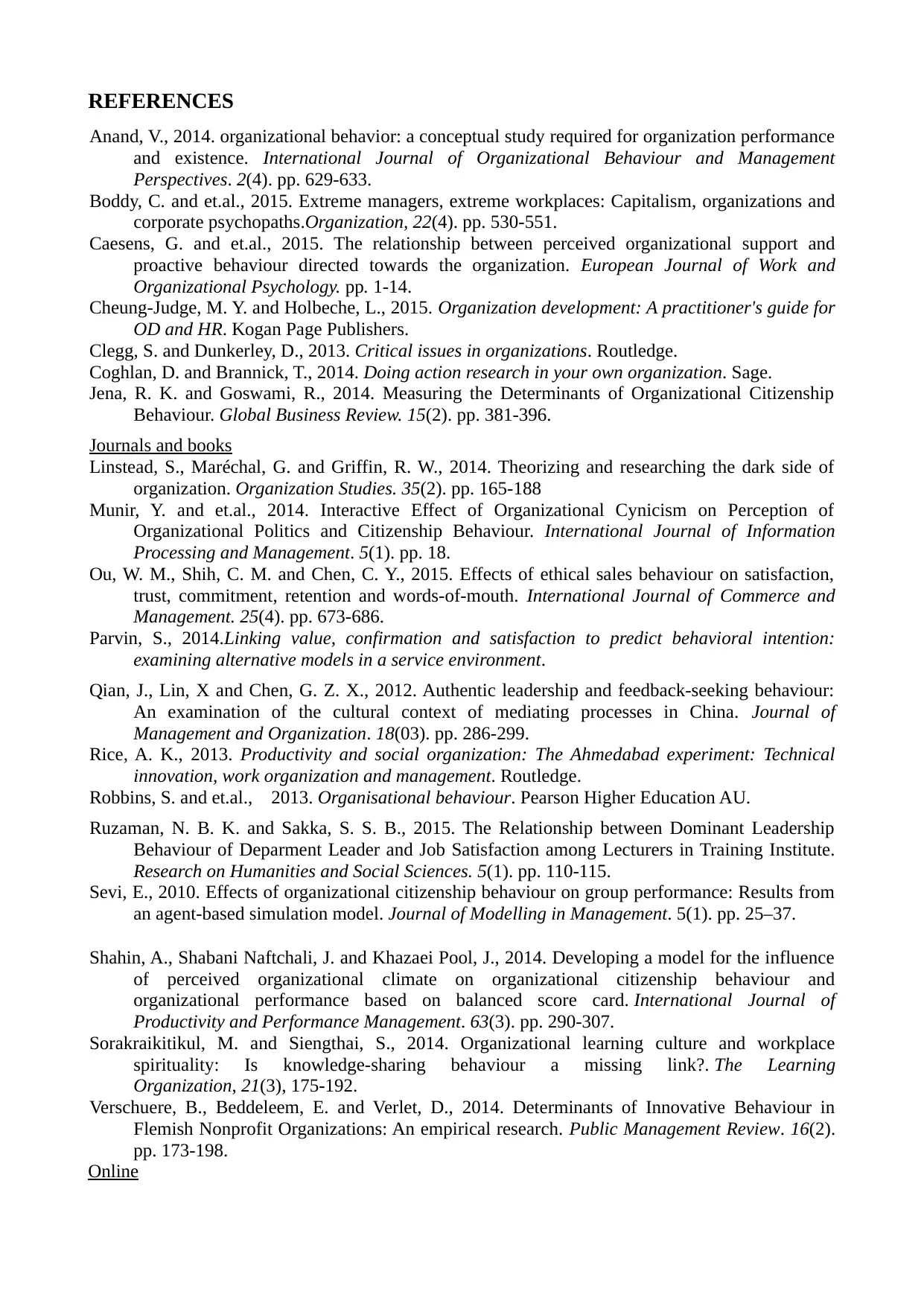
REFERENCES
Anand, V., 2014. organizational behavior: a conceptual study required for organization performance
and existence. International Journal of Organizational Behaviour and Management
Perspectives. 2(4). pp. 629-633.
Boddy, C. and et.al., 2015. Extreme managers, extreme workplaces: Capitalism, organizations and
corporate psychopaths.Organization, 22(4). pp. 530-551.
Caesens, G. and et.al., 2015. The relationship between perceived organizational support and
proactive behaviour directed towards the organization. European Journal of Work and
Organizational Psychology. pp. 1-14.
Cheung-Judge, M. Y. and Holbeche, L., 2015. Organization development: A practitioner's guide for
OD and HR. Kogan Page Publishers.
Clegg, S. and Dunkerley, D., 2013. Critical issues in organizations. Routledge.
Coghlan, D. and Brannick, T., 2014. Doing action research in your own organization. Sage.
Jena, R. K. and Goswami, R., 2014. Measuring the Determinants of Organizational Citizenship
Behaviour. Global Business Review. 15(2). pp. 381-396.
Journals and books
Linstead, S., Maréchal, G. and Griffin, R. W., 2014. Theorizing and researching the dark side of
organization. Organization Studies. 35(2). pp. 165-188
Munir, Y. and et.al., 2014. Interactive Effect of Organizational Cynicism on Perception of
Organizational Politics and Citizenship Behaviour. International Journal of Information
Processing and Management. 5(1). pp. 18.
Ou, W. M., Shih, C. M. and Chen, C. Y., 2015. Effects of ethical sales behaviour on satisfaction,
trust, commitment, retention and words-of-mouth. International Journal of Commerce and
Management. 25(4). pp. 673-686.
Parvin, S., 2014.Linking value, confirmation and satisfaction to predict behavioral intention:
examining alternative models in a service environment.
Qian, J., Lin, X and Chen, G. Z. X., 2012. Authentic leadership and feedback-seeking behaviour:
An examination of the cultural context of mediating processes in China. Journal of
Management and Organization. 18(03). pp. 286-299.
Rice, A. K., 2013. Productivity and social organization: The Ahmedabad experiment: Technical
innovation, work organization and management. Routledge.
Robbins, S. and et.al., 2013. Organisational behaviour. Pearson Higher Education AU.
Ruzaman, N. B. K. and Sakka, S. S. B., 2015. The Relationship between Dominant Leadership
Behaviour of Deparment Leader and Job Satisfaction among Lecturers in Training Institute.
Research on Humanities and Social Sciences. 5(1). pp. 110-115.
Sevi, E., 2010. Effects of organizational citizenship behaviour on group performance: Results from
an agent-based simulation model. Journal of Modelling in Management. 5(1). pp. 25–37.
Shahin, A., Shabani Naftchali, J. and Khazaei Pool, J., 2014. Developing a model for the influence
of perceived organizational climate on organizational citizenship behaviour and
organizational performance based on balanced score card. International Journal of
Productivity and Performance Management. 63(3). pp. 290-307.
Sorakraikitikul, M. and Siengthai, S., 2014. Organizational learning culture and workplace
spirituality: Is knowledge-sharing behaviour a missing link?. The Learning
Organization, 21(3), 175-192.
Verschuere, B., Beddeleem, E. and Verlet, D., 2014. Determinants of Innovative Behaviour in
Flemish Nonprofit Organizations: An empirical research. Public Management Review. 16(2).
pp. 173-198.
Online
Anand, V., 2014. organizational behavior: a conceptual study required for organization performance
and existence. International Journal of Organizational Behaviour and Management
Perspectives. 2(4). pp. 629-633.
Boddy, C. and et.al., 2015. Extreme managers, extreme workplaces: Capitalism, organizations and
corporate psychopaths.Organization, 22(4). pp. 530-551.
Caesens, G. and et.al., 2015. The relationship between perceived organizational support and
proactive behaviour directed towards the organization. European Journal of Work and
Organizational Psychology. pp. 1-14.
Cheung-Judge, M. Y. and Holbeche, L., 2015. Organization development: A practitioner's guide for
OD and HR. Kogan Page Publishers.
Clegg, S. and Dunkerley, D., 2013. Critical issues in organizations. Routledge.
Coghlan, D. and Brannick, T., 2014. Doing action research in your own organization. Sage.
Jena, R. K. and Goswami, R., 2014. Measuring the Determinants of Organizational Citizenship
Behaviour. Global Business Review. 15(2). pp. 381-396.
Journals and books
Linstead, S., Maréchal, G. and Griffin, R. W., 2014. Theorizing and researching the dark side of
organization. Organization Studies. 35(2). pp. 165-188
Munir, Y. and et.al., 2014. Interactive Effect of Organizational Cynicism on Perception of
Organizational Politics and Citizenship Behaviour. International Journal of Information
Processing and Management. 5(1). pp. 18.
Ou, W. M., Shih, C. M. and Chen, C. Y., 2015. Effects of ethical sales behaviour on satisfaction,
trust, commitment, retention and words-of-mouth. International Journal of Commerce and
Management. 25(4). pp. 673-686.
Parvin, S., 2014.Linking value, confirmation and satisfaction to predict behavioral intention:
examining alternative models in a service environment.
Qian, J., Lin, X and Chen, G. Z. X., 2012. Authentic leadership and feedback-seeking behaviour:
An examination of the cultural context of mediating processes in China. Journal of
Management and Organization. 18(03). pp. 286-299.
Rice, A. K., 2013. Productivity and social organization: The Ahmedabad experiment: Technical
innovation, work organization and management. Routledge.
Robbins, S. and et.al., 2013. Organisational behaviour. Pearson Higher Education AU.
Ruzaman, N. B. K. and Sakka, S. S. B., 2015. The Relationship between Dominant Leadership
Behaviour of Deparment Leader and Job Satisfaction among Lecturers in Training Institute.
Research on Humanities and Social Sciences. 5(1). pp. 110-115.
Sevi, E., 2010. Effects of organizational citizenship behaviour on group performance: Results from
an agent-based simulation model. Journal of Modelling in Management. 5(1). pp. 25–37.
Shahin, A., Shabani Naftchali, J. and Khazaei Pool, J., 2014. Developing a model for the influence
of perceived organizational climate on organizational citizenship behaviour and
organizational performance based on balanced score card. International Journal of
Productivity and Performance Management. 63(3). pp. 290-307.
Sorakraikitikul, M. and Siengthai, S., 2014. Organizational learning culture and workplace
spirituality: Is knowledge-sharing behaviour a missing link?. The Learning
Organization, 21(3), 175-192.
Verschuere, B., Beddeleem, E. and Verlet, D., 2014. Determinants of Innovative Behaviour in
Flemish Nonprofit Organizations: An empirical research. Public Management Review. 16(2).
pp. 173-198.
Online
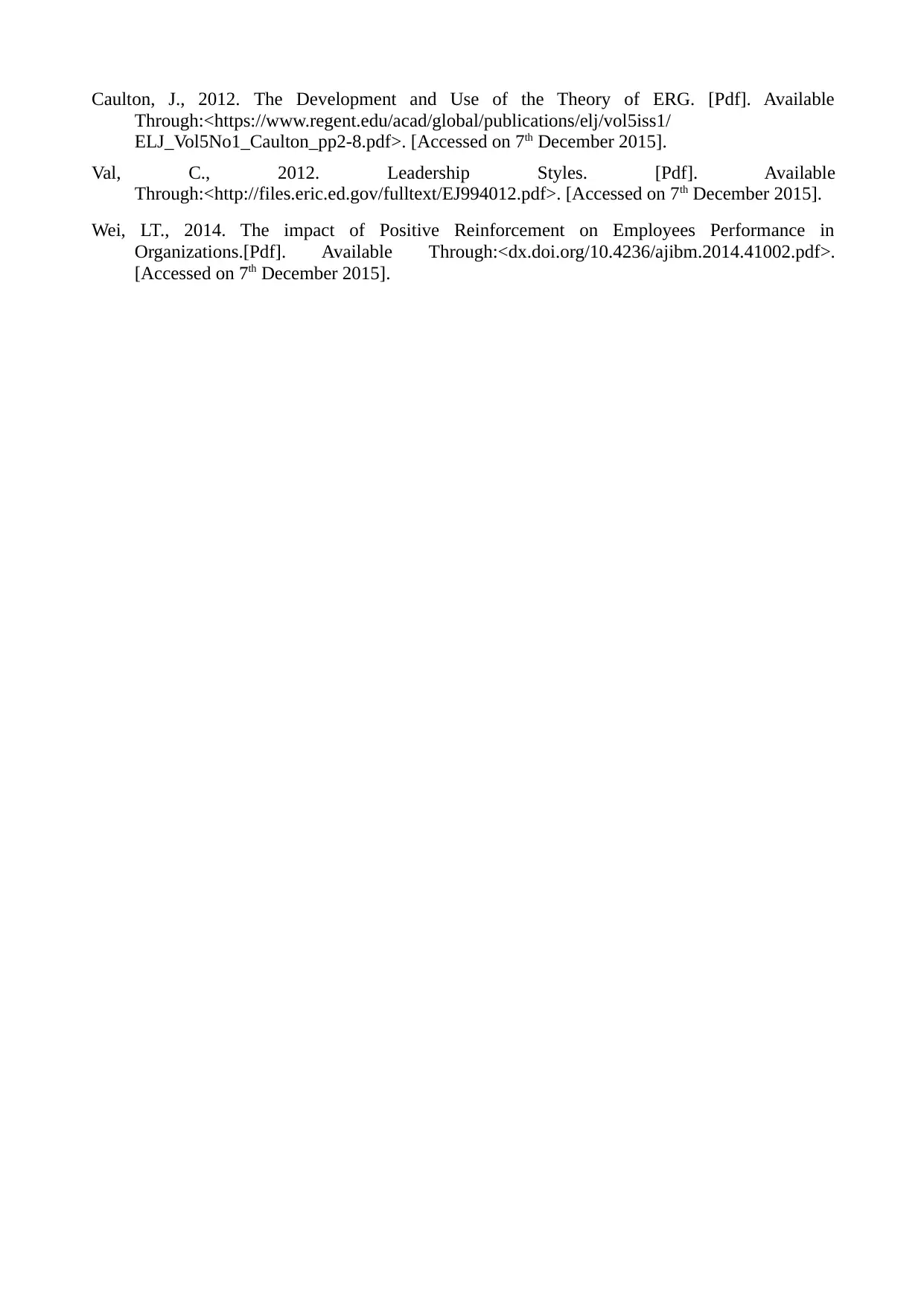
Caulton, J., 2012. The Development and Use of the Theory of ERG. [Pdf]. Available
Through:<https://www.regent.edu/acad/global/publications/elj/vol5iss1/
ELJ_Vol5No1_Caulton_pp2-8.pdf>. [Accessed on 7th December 2015].
Val, C., 2012. Leadership Styles. [Pdf]. Available
Through:<http://files.eric.ed.gov/fulltext/EJ994012.pdf>. [Accessed on 7th December 2015].
Wei, LT., 2014. The impact of Positive Reinforcement on Employees Performance in
Organizations.[Pdf]. Available Through:<dx.doi.org/10.4236/ajibm.2014.41002.pdf>.
[Accessed on 7th December 2015].
Through:<https://www.regent.edu/acad/global/publications/elj/vol5iss1/
ELJ_Vol5No1_Caulton_pp2-8.pdf>. [Accessed on 7th December 2015].
Val, C., 2012. Leadership Styles. [Pdf]. Available
Through:<http://files.eric.ed.gov/fulltext/EJ994012.pdf>. [Accessed on 7th December 2015].
Wei, LT., 2014. The impact of Positive Reinforcement on Employees Performance in
Organizations.[Pdf]. Available Through:<dx.doi.org/10.4236/ajibm.2014.41002.pdf>.
[Accessed on 7th December 2015].
1 out of 12
Related Documents
Your All-in-One AI-Powered Toolkit for Academic Success.
+13062052269
info@desklib.com
Available 24*7 on WhatsApp / Email
![[object Object]](/_next/static/media/star-bottom.7253800d.svg)
Unlock your academic potential
© 2024 | Zucol Services PVT LTD | All rights reserved.





